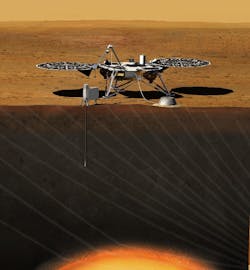Lockheed Martin selected to build InSight spacecraft for NASA’s next mission to Mars
DENVER, 21 Aug. 2012. Engineers at Lockheed Martin (NYSE:LMT) Space Systems Company in Denver will build and operate the spacecraft for NASA's next Discovery mission: Interior Exploration using Seismic Investigations, Geodesy, and Heat Transport (InSight).
NASA Jet Propulsion Laboratory (JPL) Principal Investigator Bruce Banerdt will lead the mission, intended to culminate in the first measurements of the interior of Mars. The information gleaned is expected to provide insight into the evolution of the terrestrial planets. The cost of the mission, excluding the launch vehicle and related services, is capped at $425 million (in 2010 dollars).
"Exploration and discovery are fundamental to our progress, and we are very proud to play a role in making it happen,” notes Jim Crocker, vice president and general manager of Civil Space at Lockheed Martin Space Systems Company. “We are absolutely delighted to be a part of the InSight mission, and eager to get to work with the Jet Propulsion Laboratory in moving this mission from the drawing board to the surface of Mars.”
The InSight lander is expected to be launched in 2016 and reach the Red Planet later the same year, landing at Elysium Planitia, a flat area near the planet's equator.
The InSight terrestrial planet explorer will address one of the most fundamental issues of planetary and solar system science, says a spokesperson: understanding the processes that shaped the rocky planets of the inner solar system (including Earth) more than four billion years ago.
The InSight lander will install a seismograph and heat flow probe into the Martian surface. Using geophysical instruments, InSight will delve deep beneath the surface of Mars, detecting the fingerprints of the processes of terrestrial planet formation, as well as measuring the planet's "vital signs,” such as "pulse" (seismology), "temperature" (heat flow probe), and "reflexes" (precision tracking).
The InSight mission is similar in design to the Mars lander that the Phoenix mission used in 2008 to study ground ice near the north pole of Mars. Reuse of this technology, developed and built by Lockheed Martin, will provide a low-risk path to Mars without the added cost of designing and testing a new system from scratch.
Space Systems Company, an operating unit of Lockheed Martin Corp., designs and develops, tests, manufactures, and operates human space flight systems; a full range of remote sensing, navigation, meteorological, and communications satellites and instruments; space observatories and interplanetary spacecraft; laser radar; ballistic missiles; missile defense systems; and nanotechnology research and development.

